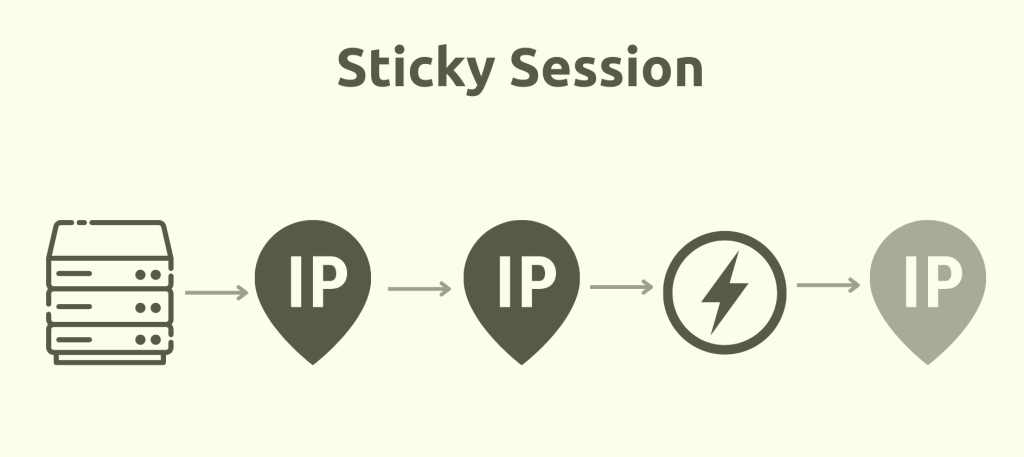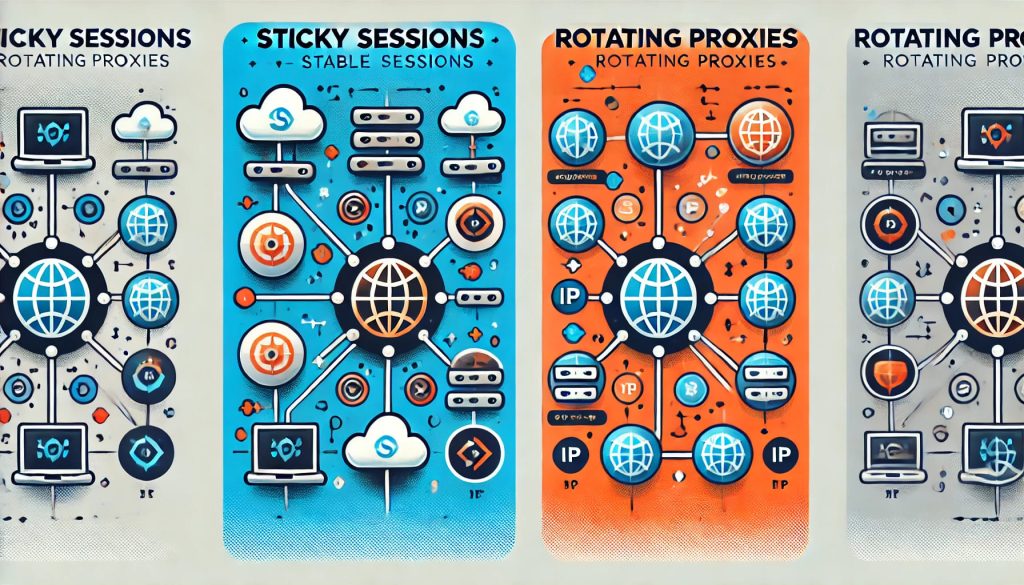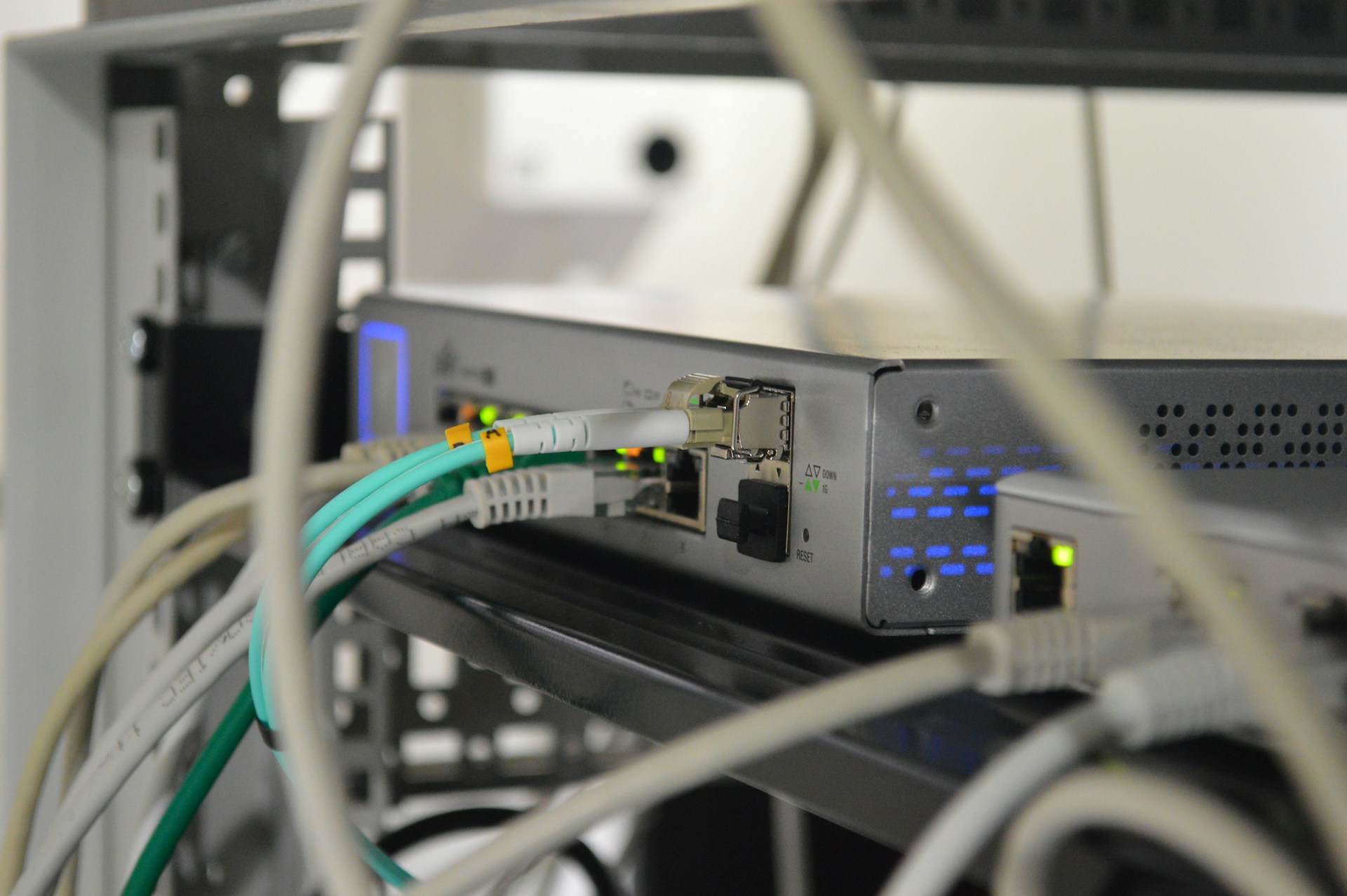
Proxy servers are one of the key tools for anonymous surfing, data collection and automation of various processes. They allow hiding a user’s real IP address, bypassing restrictions, and masking activity. An important component is mobile proxy services, which allow you to use IP addresses obtained from mobile operators.
There are two main types of proxy: sticky and rotating. Both types have features, advantages and limitations. Let’s understand what sticky and rotating proxies are, what are the differences and which option is suitable for specific tasks.
What are sticky sessions and rotating proxies?
Sticky sessions and rotating proxies are terms related to internet marketing, data parsing. They help to provide stable, anonymous connections when accessing remote servers. Next, let’s consider what sticky proxies are and their differences from rotating proxies.
What are sticky proxies?
Sticky proxies assign a user one IP address for a specific period of time, usually from a few minutes to a few hours.
Sticky Sessions are a technique that keeps a user on the same server or resource for the duration of a session. Such sessions ensure that requests from a single user or bot are sent to the same server, ensuring connection stability and proper processing.
Features of sticky proxies:
- Provide a stable IP address for the duration of the session. This means that requests originating from a single user will be routed from the same IP address for the duration of the session. This avoids IP address changes, which is important for some operations, such as during the authorization process or when making purchases.
- Avoid frequent checks and blocking as the activity looks more natural. When a connection is made with a persistent IP, it looks more organic and less likely to attract the attention of site security systems. This helps reduce the likelihood of a session being blocked or flagged as suspicious.
- Ideal for working with sites that require a persistent IP address. For example, for interacting with social networks, online stores where a constant connection from a single user is necessary to complete actions.
They are suitable for scenarios where it is important that interaction with a web resource occurs without IP address changes and the session remains stable.

How do Rotating Proxies work?
Now let’s look at how Rotating Proxies work. This is a system of servers that automatically change IP addresses with each request or at predetermined intervals. They make the process anonymous and allow the use of multiple IP addresses, reducing the risk of blocking and increasing the efficiency of data collection from different web resources.
The principle of operation is rotating:
- Each request is sent from a new IP address. They automatically change the IP address for each request, ensuring anonymity and masking the source of traffic. This makes it difficult to track activity and helps avoid blocking.
- Allow you to bypass anti-bot systems and captchas. Systems such as captchas are often used to check if a user is a bot. Since each request comes from a new IP address, this helps avoid being recognized as an automated system and reduces the chance of getting to pages with captchas.
- They are used for data parsing, mass queries and process automation. Indispensable for collecting data from websites, mass requests to various resources, as well as for automating actions, such as registering on platforms or placing requests.
- By constantly changing IP addresses, avoid blocking and restrictions, making them indispensable for automated tasks. Changing IP addresses make it difficult for sites and anti-bot systems to identify and block the source of traffic, allowing tasks to continue without interruption, circumventing restrictions.
By constantly changing IP addresses, rotating proxies avoid blocking and restrictions, making them indispensable for automated tasks.
Difference between sticky and dynamic proxies
The difference between sticky and dynamic proxies is the frequency of IP address changes. Sticky ones keep one IP address for the duration of the session, ensuring a stable connection. Dynamic (rotating) ones change IP address regularly. This helps avoid blocking and enhances anonymity.
Key differences:
IP stability: sticky has a persistent IP address throughout the session, which is important for working with sites that require a persistent IP (e.g., for shopping or permanent authorization). Spinners change IP address with each subsequent request, which provides anonymity and is difficult to track.
Blocking bypass: Spinning ones are much harder to track and block because they use multiple IP addresses, making them more stealthy to work with. Sticky proxies can be easier to detect because they use the same IP throughout a session.
Usage: sticky proxies are ideal for long-term work with sites that require IP address permanence, such as social networks, online stores or services that require a permanent session. Rotating proxies, on the other hand, are optimal for large-scale automated tasks such as data parsing, bulk queries or process automation where it is important to bypass restrictions and avoid blocking.
The choice between these types of proxies depends on the goals: if IP address stability is important for work, for example, for operations requiring a long session, it is better to choose sticky proxies. If you need to ensure anonymity and protection from blocking, especially for data parsing or mass requests, rotational ones will be effective.
Advantages of sticky proxies
Sticky proxies have a number of significant advantages that make them in demand for certain scenarios.
Advantages of sticky proxies:
- Connection stability: one IP address is stored for the entire session, which is ideal for handling personal accounts or lengthy processes such as ordering, signing up for platforms or running a business. This eliminates the need to constantly reconnect and change IPs.
- Less likelihood of blocking: because the IP doesn’t change too often, activity appears more natural and sites are less likely to notice suspicious behavior. This avoids blocking or restrictions due to frequent IP address changes.
- Suitable for online stores, social networks, advertising: such platforms require a stable connection, for example, to place advertising campaigns, work with personal profiles or make purchases.
- Use is justified if it is important to keep a constant IP address and avoid suspicious changes in the session: if long-term activity with a constant IP is required for work, sticky proxies become an indispensable tool. This is especially true when it is important to avoid security interference or account lockout.
Sticky proxies strike a balance between stability and security, making them ideal for tasks that require long sessions and minimize the risk of blocking.
Disadvantages of sticky proxies
Despite the advantages, sticky proxies have limitations.
- Limited IP resources: if a site blocks the IP address being used, it can only be changed via a session update, which can result in a lengthy interruption or the need to restart the process. This limits flexibility and speed of action when interacting with blocked sites.
- Not suitable for mass data collection: due to the stability of the IP address, sticky proxies can be blacklisted faster with a large number of requests. This makes them less useful for parsing data on a scale that requires circumventing restrictions.
- Less anonymous: Because the IP is stored longer, analyzing user activity becomes easier for security systems and site administrators. This makes them less suitable for tasks that require a high level of anonymity, such as working covertly with multiple accounts or circumventing geo-restrictions.
These limitations make sticky proxies less convenient for tasks where high anonymity or frequent IP address changes are important, such as bulk data parsing or bypassing complex anti-bot systems.
Advantages of rotating proxies
Rotating proxies are used in situations where you need to avoid blocking and leave a minimal digital footprint. They are ideal for tasks where anonymity and bypassing site security mechanisms are important.
Pros of rotary proxies:
- High anonymity: the IP address changes regularly, making it difficult to track and identify the user. Site security systems cannot easily identify the source of traffic.
- Suitable for web scraping and parsing: frequent IP address changes allow you to bypass restrictions such as query limits or IP blocking, which is critical when parsing large amounts of data from different sources.
- Bypassing anti-bot systems: with regular IP changes, sites are harder to detect automated activity. They reduce the probability of getting to pages with captcha or anti-bot protection, as each request will come from a new address.
Thanks to these advantages, rotary proxies are indispensable for automated processes and work with large amounts of data, such as mass registration, scraping, or fulfillment of online requests where high speed and anonymity are important.
Disadvantages of rotating proxies
Although rotating proxies offer high anonymity, they have disadvantages too.
Minuses:
- Unstable connection – changing IPs can cause a session to break.
- Some sites block frequent IP changes – for example, social networks may consider it as suspicious activity.
- Can cause problems with authorization – some services require confirmation when changing IP.
Due t these disadvantages, rotational proxies are not always suitable for tasks where connection stability is important.

Which proxies are better: sticky or rotary?
The choice between sticky and rotary proxies depends on the goals you are pursuing. This choice is not always obvious. Both types of proxies have strengths and weaknesses. To understand which proxies are better sticky or rotary in a particular situation, you need to consider certain factors.
Which type of proxy to choose?
If you need connection stability – choose sticky proxies. This type keeps one IP address for the duration of the session, which is ideal for working with accounts, including on social networks, as well as for long-term advertising campaigns. Sticky proxies ensure that the connection is stable and won’t be interrupted while you’re working, whether you’re placing orders or interacting with online platforms. With their help, you can safely perform operations without worrying about frequent IP changes.
If anonymity and blocking bypass are important, rotational proxies are preferable. They change IP address with each request, which avoids blocking and traces that can be left by prolonged activity with the same address. An additional solution for anonymity is SIM hosting, which uses mobile networks to connect, making it difficult to trace the source of traffic.
If the work is related to several services – use a combined approach. For example, for regular work with personal accounts or advertising, you can use sticky ones for stability, and for parsing or bypassing blocking – rotational ones to reduce the probability of getting blocked.
To check and monitor the selected proxies, you can use the Proxy Checker tool, which will help you make sure that they work, are fast and anonymous.
Use scenarios for sticky and rotational proxies
Sticky proxies are suitable for:
- Social media management.
- Promotion in online advertising.
- Long-term account management.
Rotational proxies are useful for:
- Web scraping and data parsing.
- Bypassing anti-bot systems.
- Automated surfing on the Internet.
Depending on your goals, choose the right type of proxy or both at the same time.
Conclusion: what to choose for your tasks?
The choice between sticky and rotational proxies depends on the goals. If stability is important, it is better to use sticky proxies, if anonymity and protection from blocking – rotational proxies. The right strategy is sometimes to combine both options.
Before buying a proxy, it is important to clearly define your objectives in order to choose the best solution and avoid problems.









